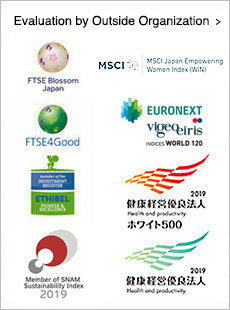Informing Society of JSR Group’s Strengths
Reflecting Business Dynamism on Materiality
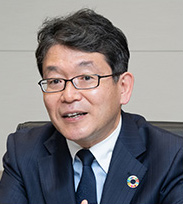 Thank you for allowing me to participate in this dialogue. The first point I’d like to address from the standpoint of an investor is the fact that JSR Group is reevaluating its materiality in conjunction with its mid-term business plan. The very fact that JSR’s materiality will be reevaluated each time a new mid-term business plan is established in itself communicates the message that JSR sees financial value and non-financial value as being equal. I think this is a manifestation of what is known as “integrated thinking”* and proof that business management and CSR activities are being pursued in an integrated manner.
Thank you for allowing me to participate in this dialogue. The first point I’d like to address from the standpoint of an investor is the fact that JSR Group is reevaluating its materiality in conjunction with its mid-term business plan. The very fact that JSR’s materiality will be reevaluated each time a new mid-term business plan is established in itself communicates the message that JSR sees financial value and non-financial value as being equal. I think this is a manifestation of what is known as “integrated thinking”* and proof that business management and CSR activities are being pursued in an integrated manner.
* Integrated thinking: A way of thinking that sees corporate activity in its entirety by integrating financial and non-financial information
- Kuroda:
- I understand that you review your materiality simultaneously with your mid-term business plan every three or so years. The world has changed drastically between three years ago and now. I think it’s good that JSR’s materiality will continue to be reevaluated every three years based on anticipated great changes in the world and society.
- The word “materiality” is taking on a slightly different perspective when viewed in terms of ESG investment. In the past, a matrix was prepared based on two axes—namely, “importance from the standpoint of multiple stakeholders” and “importance for the company.” Those points lying within the “high importance” area for both in the upper right of the matrix were considered “materiality.” But what investors want to know is very simple. First of all, and this is very important, they want to know if the company is a strong company—one with high earning power—that is worth investing in. Then they want to know if the company can maintain its strength into the medium and long term; in other words, they want to know its corporate value.
- Kuroda:
- I agree. For example, in most cases, there’s a gap in terms of achievement between goals ultimately established to resolve important issues and currently-available technologies and business models. How will that gap be rectified? This is a matter of concern not only for investors but also society at large.
- Whether or not JSR Group can maintain its current strengths for the long term is of course important. As its point of view, if we look at the current material items arranged into the three categories of “business opportunity,” “business risk,” and “business foundation” from this standpoint, I think these items have been well identified, without much excess or omission.
On the other hand, if we look at information disclosure, all companies in Japan’s chemical industry grapple with the same issues, and thus their orientations and strategies in such non-financial areas as materiality and ESG are very similar. So, if you ask me whether JSR Group’s strengths are being differentiated from those of its competitors through this form of disclosure, I would say probably not as well as they could be. - Kuroda:
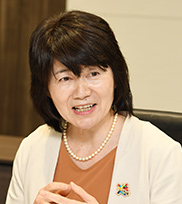 Many companies view materiality from two aspects—namely, “active” and “passive” materiality. But it may be that this conventional way of identifying materiality is gradually falling out of step with reality. For example, in the life sciences, there are “active” aspects, such as extending healthy life expectancy. But, at the same time, human rights issues may emerge. As this shows, there are always both positive and negative sides in all things. So my sense is that it is no longer possible to speak of individual items in terms of “this is active” and “this is passive.”
Many companies view materiality from two aspects—namely, “active” and “passive” materiality. But it may be that this conventional way of identifying materiality is gradually falling out of step with reality. For example, in the life sciences, there are “active” aspects, such as extending healthy life expectancy. But, at the same time, human rights issues may emerge. As this shows, there are always both positive and negative sides in all things. So my sense is that it is no longer possible to speak of individual items in terms of “this is active” and “this is passive.”- One of JSR Group’s strengths is that its three mainstay businesses are each firmly responding to social issues. Given the dynamic nature of the Group’s businesses, characterized by, for example, the M&As taking place in life sciences and innovation in such forms as “materials x digitalization,” rather than presenting materiality in terms of “active” and “passive” aspects, it might be better to tie its characteristics to materiality for presentation to the public. This approach should be able to convey your “story” of developing new business models that look two or three decades into the future and achieving even greater growth through them.
- Kuroda:
- Then it is important to apply the SDGs, which are global issues, and prioritizing items from the 169 targets of the 17 goals that can take advantage of JSR Group’s strengths. There is no need to insist on continuity and classification with the previous materiality. Bring an SDG that you want to put particular focus on to the forefront and then take an “outside-in” approach.* From there it is important to prepare a road map or “story” that leads to its resolution.
* Outside-in approach: A way of setting organizational goals that is based on social issues.
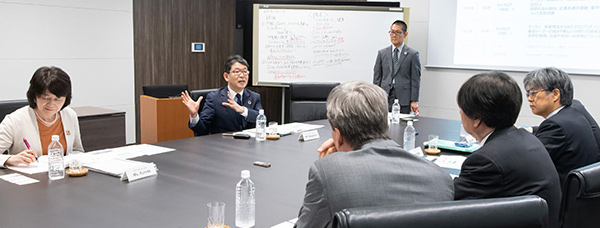
Getting Society to Recognize the Value that Technology Produces
- Kawahashi:
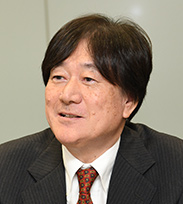 You said something that is very insightful when you mentioned tying future business reform and materiality. For example, take “Climate Action,” which is SDG number thirteen. If our business grows well and our production increases, our CO2 emissions will also naturally increase. However, thinking of decreasing production and plant lines in order to prevent global warming is nonsense when seen from a corporate perspective. Instead, I think JSR should be a company that makes a contribution through environment-friendly products like SSBR, which improves cars’ fuel efficiency, and technical innovations that reduce carbon dioxide in terms of production units.
You said something that is very insightful when you mentioned tying future business reform and materiality. For example, take “Climate Action,” which is SDG number thirteen. If our business grows well and our production increases, our CO2 emissions will also naturally increase. However, thinking of decreasing production and plant lines in order to prevent global warming is nonsense when seen from a corporate perspective. Instead, I think JSR should be a company that makes a contribution through environment-friendly products like SSBR, which improves cars’ fuel efficiency, and technical innovations that reduce carbon dioxide in terms of production units.
And then there is the third SDG, which is “Good Health and Well-Being.” I am proud that we are making a significant contribution in the sense of raising society’s quality of life (QOL) by developing equipment that supports medical care. As Mr. Takegahara pointed out, we are also contributing to the resolution of social issues as we dynamically transform our business. I want to do more to highlight the fact that such business and our materiality are solidly linked.- Johnson:
- Our Life Sciences Business confirms strongly to the SDGs. JSR Group’s business is, quite naturally, strongly tied to better human health and living—in other words, QOL. It is our mission to improve people’s lives and health. And in this sense, the Life Sciences Business fits perfectly with this mission and therefore has high priority. The problem is, we must also firmly link our excellent technologies to revenue. It is, after all, quite difficult for a business to continue if it does not have economic sustainability. In the end, I think it will become important for our technology’s value to be recognized by society.
- In the investment world, there are such phrases as “impact-based finance” and “impact-based thinking.” Looking forward, the word “impact” will become key. When a business contributes to the resolution of social issues by growing, “impact” serves as the means of measuring that contribution quantitatively.
The chemicals industry tends to be seen as an energy-intensive industry, so no matter how many excellent environment-friendly products you produce or how much social value you have, in the end the things that are measured are consumed energy and water. But if it is possible to measure positive impacts on society, I think this will help earn society’s recognition of your value and, further, help differentiate you from your competitors. - Johnson:
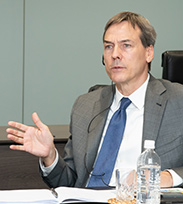 I think that’s right. But on the other hand, what concerns me most is environmental burden that is attributable to business. Recently the impact of microplastic on marine life has become a matter of global concern. Of course, at JSR, we are striving to improve the environmental performance of our products and to make highly durable products. But the question remains whether such efforts are enough, and whether they alone are the correct approach.
I think that’s right. But on the other hand, what concerns me most is environmental burden that is attributable to business. Recently the impact of microplastic on marine life has become a matter of global concern. Of course, at JSR, we are striving to improve the environmental performance of our products and to make highly durable products. But the question remains whether such efforts are enough, and whether they alone are the correct approach.- Of course, if there are positive impacts, there are also negative impacts. However, risk and opportunity are two sides of the same coin. So I think it is important to present your message as “JSR Group: A company that creates social value while controlling negative environmental impacts.”
- Kawahashi:
- Looking at the problem of microplastics, we see that biodegradable bioplastics are attracting attention as a possible solution. But my sense is that developing bioplastics that JSR does not currently have in order to provide a solution is not a choice we should make if we consider the economic risk to the company.
If we reexamine the value of an existing product or ongoing research, we often find things that are rather useful. For example, increasing the brightness of an LCD display can lower its power consumption. In other words, it can help reduce carbon dioxide and conserve energy. Our customers can control process costs without consuming massive amounts of energy by using our environment-friendly products even before our materials are commercialized and reach society. In fact, it is very important to solve problems through this kind of accumulation. The idea that it may be possible to make a greater contribution to society simply by changing our way of thinking should be the basis for approaching research and development. - Johnson:
- It is certainly possible that seeing the purpose of R&D in broader terms, without being constricted by monetization or road maps, will lead to the discovery of even greater value. It might be a good idea to add another axis to R&D to achieve that
- Kawahashi:
- It is of course important to respond sincerely to social issues. But even just thinking more flexibly and building on what we can do, without being overly concerned about those issues, should create more leeway for us to make a contribution.
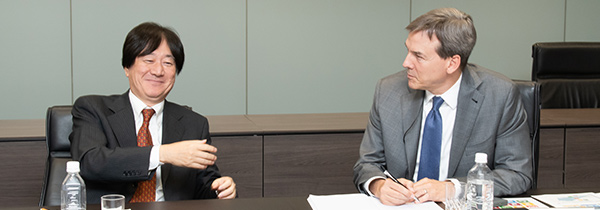
How to Best Incorporate the SDGs
- Shimizu:
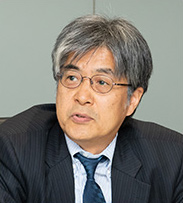 As Ms. Kuroda pointed out a moment ago, building strategies that tie solutions to problems existing in society—such as the 17 SDGs—to our own growth is extremely important. However, I question whether our premise should be that all of the SDGs are applicable. I think that when we consider our sustainability as a company, we must take our discussion a bit deeper, looking not only at achieving goals in 2030 but also at the kind of essential value we must have in the future beyond that.
As Ms. Kuroda pointed out a moment ago, building strategies that tie solutions to problems existing in society—such as the 17 SDGs—to our own growth is extremely important. However, I question whether our premise should be that all of the SDGs are applicable. I think that when we consider our sustainability as a company, we must take our discussion a bit deeper, looking not only at achieving goals in 2030 but also at the kind of essential value we must have in the future beyond that.
Specifically, the SDGs are far too comprehensive and some items have a trade-off relationship with others. For example, if we attempt to eliminate hunger, raise living standards, and increase GDP, energy consumption will also increase and the seventh SDG will not be attained. These goals have a relationship whereby “satisfying one means not satisfying another.” I think we should proceed carefully by also discussing which items to choose within the trade-off and why.- Kuroda:
- I agree. I think that when the UN prepared the SDGs, people did not expect the Global Goals to spread that much, particularly among Japanese major companies. However, behind the SDGs’ formulation is a sense of crisis concerning climate change and other issues. There are some who say that, as it becomes necessary to do business in an age of rising uncertainty when predicting the future is impossible, the successful experiences of Japanese-style management thus far are not being utilized much in dealing with the crisis. So some kind of bold change of thinking will be required. In that sense, the SDGs’ philosophy is important but there is really no need to be tied up by their 17 goals and 169 targets. I think it is acceptable to utilize those areas that you can utilize.
- Shimizu:
- In Japan, in particular, there is a strong sense that companies are expected to commit to all 17 goals. But if we look at individual companies and industries, it is apparent that choice and prioritization are required. This makes it necessary to clarify “what it is we aim to do.” Moreover, I think a process whereby we tell society that “we will do this but we won’t do that” based on evidence and gain the acceptance and understanding of our stakeholders is important. For that reason, I think it is vitally important that we raise our own literacy* with regard to quantitative information and evidence.
* Literacy: The ability to understand, apply, and utilize information given in a particular field.
- Johnson:
- Literacy is important. Literacy is also needed in communication. We must communicate with society responsibly.
- Shimizu:
- Both the “speaker” and the “listener” must improve their literacy in order to achieve good communication. I therefore think that employee education will become important in addition to better education systems in society at large. This will lead to fully developed discussion.
- Johnson:
- As for the details of the SDGs, people who hear about them almost always see things in simplistic terms. I think there is an aspect of the SDGs that is too simplified, as in “this is good and this bad.” So we have to be aware that we cannot educate all of society. We should provide better education to raise our own literacy and then take a more realistic and constructive approach.
- Companies that list all 17 SDG logos do not understand their relative importance, and so we cannot say they are good companies for having done so. If it is a business company, the items to which it can contribute through its business will naturally be limited, and those issues that demand a response in accordance with its growth vectors will inevitably become apparent. The company will then help solve social issues by extending that field. This, I think, is material, and anything else is not material. I think we can arrange things in this manner.
- Kuroda:
- Yes, I agree that “equal attention to all 17 SDGs” became the trend in Japan. One thing that impressed me was that some pharmaceutical company in Europe focused on four or so important goals from among the seventeen. Then, while linking them to their business, they spotlighted the most important one, the third SDG, which is “Good Health and Well-Being,” and presented themselves with a well-modulated message that says, “This is our goal.”
- Fujii:
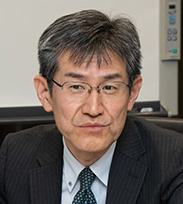 I have heard it said that “Selecting materiality is discovering issues within the scope that answers can be found that have the greatest impact inside and outside the company.” That might be true in essence.
I have heard it said that “Selecting materiality is discovering issues within the scope that answers can be found that have the greatest impact inside and outside the company.” That might be true in essence.- Kuroda:
- Speaking of the SDGs, a good number of companies in the US and Europe declared between 2015 and 2016—immediately after the SDGs were formulated—that they will tackle them. But I hear their number has been gradually falling to a certain extent more recently. The more that companies venture into the SDGs’ essence, the more they realize how high a hurdle the SDGs actually present. However, even so, the SDGs have achieved such a level of global recognition that I see no way but to use them.
- Some people use the SDGs as a tool for discovering social issues. But what about finding the issues first and then considering how one can be of use in solving them? This might be the correct way of using them. But, like I said at the beginning, what we investors want is to make our investments after choosing companies that will survive with a strong business model. Accordingly, the question is whether or not the company can grasp the social issues it will face twenty or thirty years in the future and can use those issues as a source of its own growth.
Previously I found explaining the grasping of social issues to be rather troublesome. But then the SDGs came out and became a kind of international language with the participation of stakeholders from around the world. Companies can extend their core competencies* based on them and, as a result, help resolve social issues. Narrowing down the SDGs that you will commit to and then showing the public that you have a strategy and long-term plan that is based on them—I think that is another way of using the SDGs.* Core competency: The competitive core part of a company’s abilities.
- Kawahashi:
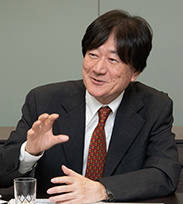 I am proud to say that, even before the SDGs existed, JSR did not engage in business that ignored the issues covered by their goals and targets. For example, when we procure raw materials, we conduct a detailed study of the “country risks”—including factors concerning human rights—of the country where the production plant is located. We thus see our procurements as being screened from the very beginning.
I am proud to say that, even before the SDGs existed, JSR did not engage in business that ignored the issues covered by their goals and targets. For example, when we procure raw materials, we conduct a detailed study of the “country risks”—including factors concerning human rights—of the country where the production plant is located. We thus see our procurements as being screened from the very beginning.
With or without the SDGs, we first arrange and analyze how our business and CSR activities fit within society and then check them against the direction we should be taking going forward. If anything is amiss, I want to view it as an important issue that needs addressing at that moment and to discuss it specifically with reference to materiality.

